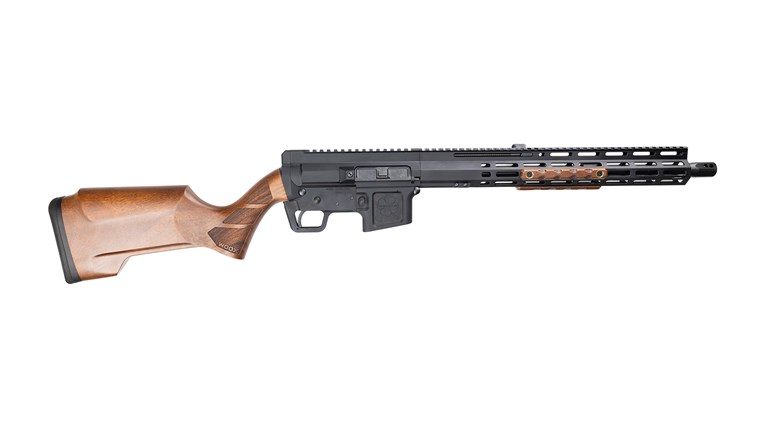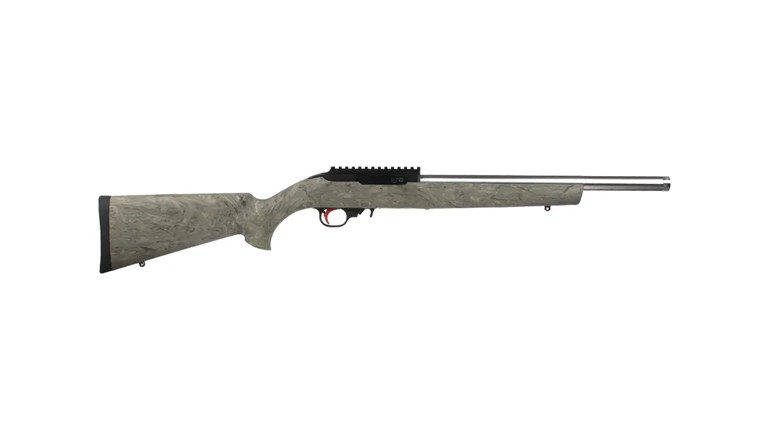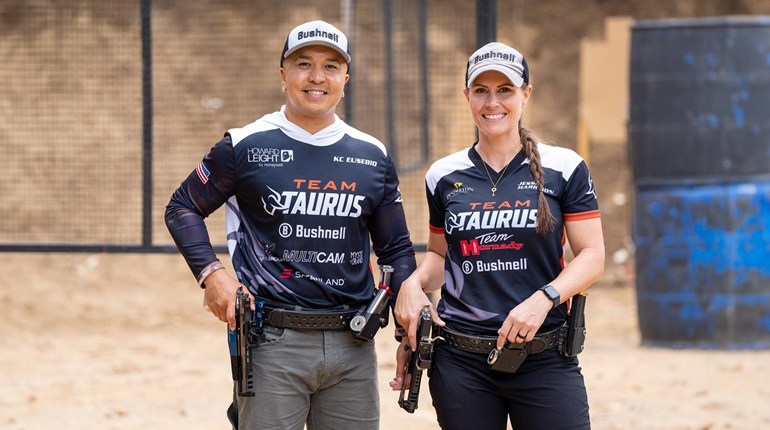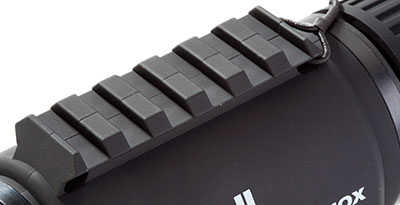
A molded rail allows attachment of auxiliary- lighting devices.
I pretend to know something about the overwhelming number of commercial night-vision devices (NVDs) available today, but the truth is I have fallen behind over the past few years. Digital night vision (DNV) is a prime example of an unfamiliar and new technology that is changing the field of NVDs, so I was eager to jump at a recent opportunity to test
Bushnell’s 3x30 mm Equinox.
The primary allure of DNV devices is their low cost. Pricing ranks alongside first-generation (Gen 1) image-intensified (I²) devices, coming in at less than $300 for entry-level units. Considering a Gen 3 I² NVD runs about 11-times higher, DNV begins to look like an awfully pretty partner across the darkened dance floor. Other advantages to DNV devices include lighter weight and less susceptibility to damage from direct lighting sources. The trade-off comes with poorer performance, which was reaffirmed during my testing.
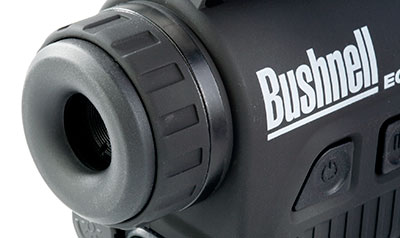
Focus is achieved through the diopter ring around the eyepiece, which allows light to escape the unshrouded area.
The Equinox is protected by a soft-rubber coating and a matching, lanyard-retained lens cover. The unit is small, lightweight and fits well in-hand, and can also be mounted on a tripod via a standard threaded insert on the device’s bottom. Two CR123 lithium batteries provide approximately six hours of run time, provided the on-board infrared (IR) illuminator is not used. A press of the power button presents a small, rectangular green/black image. A rear-mounted button switches the Equinox to black-and-white mode, which some people find easier on the eye. The rubber boot covering the color-mode button on my test unit came off easily, which could open the switch up to moisture problems if the tiny boot was lost.
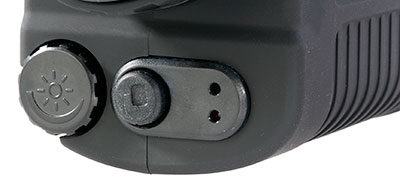
Brightness adjustments are made with the twist of a dial, while a push-button changes display from the standard infrared green to a more eye-friendly black and white. Try to avoid losing the small rubber boot covering the display button.
I should point out that regardless of the display color, your natural night vision is greatly diminished after looking at any illuminated image. I always try to use the same eye for monoculars and scopes, leaving the other for natural, unaided vision. Focus is first achieved via an eyepiece diopter ring, followed by the objective focus, which is used to see objects at different distances. The fixed IR illuminator is activated by pressing another button. A much-needed brightness-adjustment knob allows the user to increase or decrease the amount of light reaching the eye, and a video-out port is also present.
Bushnell’s Equinox instruction manual claims these digital night-vision scopes have “resolution and image quality equal to or exceeding Gen 2 analog units.” Good quality Gen 2 I² devices are excellent night-vision tools, so I was eager to get this little device out to the woods for testing. By sheer coincidence, my wife and I were asked to help a local farmer manage his coyote problem the same day my test unit arrived. After familiarizing ourselves with the scope and testing the functions in our backyard, we packed it along with my own Gen 3+ monocular and headed to the farm. I know from experience a good IR floodlight helps spot fast-moving animals, so I attached a
SureFire M951 to the Equinox’s molded-in rail section. We planned to use both the built-in IR illuminator and the SureFire with IR cover for greater range once we began looking for predators.
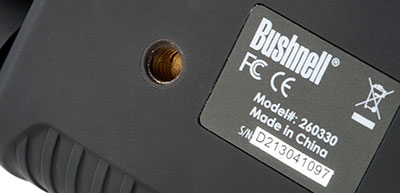
The bottom of the unit includes a threaded tripod-attachment port.
The November night sky was clear and provided a waxing quarter moon just above the horizon. Once in position, we fired up both NVDs and began calling and watching. Unfortunately, the Equinox was just not up to this task. The field of view is very small when compared to other handheld scopes, and even with the
SureFire’s 120 lumens blazing away in IR mode, the Equinox could not see any detail beyond about 40 yards. We were hunting over a field that extended 200 yards, and though the far wood line and a slight mid-field rise were vaguely discernible, there was no way to know whether the shapes we were looking at were stumps, shadows or animals—except for the larger blobs that went moo. Like a Gen 1 NVD, the Equinox was all but useless without IR assistance. Conversely, my Gen 3 device provided a commanding view of the entire area with no IR flood assistance. But that is an apples-to-oranges comparison since my NE-PVS-14 has a top-of-the-line Exelis tube and is not magnified. The Equinox’s 3X fixed magnification and CCD chip for image conversion affect both the field-of-view and image quality.
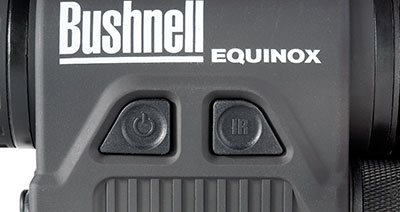
Controls are intutitive and located for easy access when holding the Equinox. Power to the unit is controlled by the button closest to the eye, while the infrared illuminator is activated and deactivated by the other button.
But neither was the Equinox on par with Gen 2 I² NVDs. I spent many a long Army night moving through the woods and watching over fields of fire using Gen 2 NVDs with acceptable degrees of clarity. Neither action would be feasible with this device without IR flood assistance, and even with that help, observation range was very limited. My wife and I agreed we could see the field as well with unaided eyes as we could with the Equinox, thanks in part to the clear sky. The Equinox would likely have changed that balance under clouds.
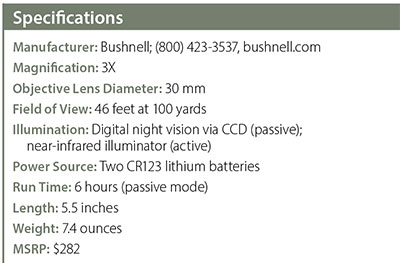
One thing to remember is most low-priced commercial units like the Equinox give off a fair amount of visible light via LED indicators, unshrouded eyepieces and IR floods (when used). All of this light is very easy for other NVD users to see. The Equinox did provide a clear picture of dense vegetation around us. Turning on the IR feature and focusing the objective at 10 feet allowed me to pick a clear lane through the woods during movement, provided I moved slowly. The digital image’s refresh rate was such that moving quickly was not really an option, but the clarity in this mode was very good. The
Equinox’s small size, light weight and low cost make it an attractive entry-level NVD suitable for getting to a tree stand, following a trail or searching for lost equipment at night.




















